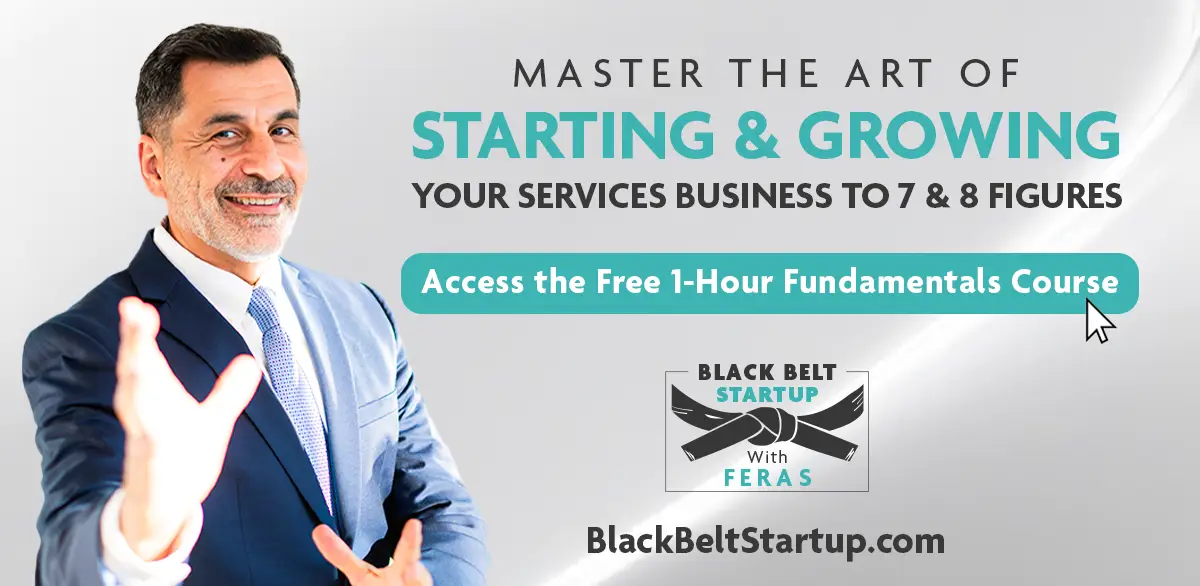5 Types of Leads to Run Away From

“You can’t do a good deal with bad people, and you can’t do a bad deal with good people.”
– Christina Tosi, Chef and Restaurateur
As the owner of a small consulting business, you always need more clients to continue growing. I have grown and exited multiple service businesses myself and understand the struggle. Whenever I speak with service startup founders, I always get asked how to get more consulting clients. In this article, I focus on one key aspect of my strategy: instead of just getting more clients, getting more of the right client and avoiding the wrong ones!
There are a lot of ways to get new consulting clients. You can get in front of more prospects by creating content like blog posts and videos and making sure they’re properly optimized to be found by using good SEO. You can scroll through LinkedIn and send messages to decision-makers in the industry you’re targeting. You can spend countless hours sharpening your value proposition. And so much more.
But I’m not here today to talk about the different ways to get more consulting prospects. In this piece, I want to draw an important distinction: the question shouldn’t be, how do I get clients for my consulting business? But rather, how can I free up time and energy to find the ideal clients for my consulting services? The latter question is a more worthwhile inquiry.
Watch the video where I cover this topic in depth:
Why You Should Focus on Finding Great Consulting Clients
If you have ever had coworkers or even been involved in a school group assignment, you understand how the wrong people can disrupt your work. One lazy, annoying, aggressive, or finger-pointing person can ruin a day, week, or entire project.
Maybe you just thought of one person in particular from your past (or present). Keep this person in mind for a minute, because the difficulty they caused is a fraction of the potential difficulties you might encounter with the wrong types of clients.
The wrong clients can steal your time, energy, and focus, plus end up causing more problems than they’re worth. Instead of just trying to get more clients, focus on winning clients whom you will enjoy serving. They can supercharge your energy and business, and accelerate growth.
Some business owners get into the mindset trap of selling themselves. Just as leads assess you during the sales process, you as a business owner should assess them too. Don’t be desperate and take the bad ones. You should also assess each one of them and think about how they would do as a potential client. Consider if they would be a good fit for you, and your business, and if you’d enjoy working with them.
You are your own boss, but remember that each client is a mini-boss in a way. It’s tempting to take on the first lead who says yes to the services you offer, especially if you’re a new business or a new consultant. Learning to say no to the wrong clients, even if you could use the money, helps make room for better, more lucrative new clients.
With that in mind, here are 5 types of leads you don’t want as clients and the red flags to identify them before it’s too late.
The 5 Bad Client Types To Avoid in Your Startup
1. The Jerk
Most people you will meet in your service-based business life are decent and professional. But every so often, you will run into a lead who is totally unreasonable. This is the jerk.
Indicators you are talking to a jerk include:
- They constantly interrupt you
- They love talking about their accomplishments
- They brag about how hard they squeeze vendors
- They’re proud of some ethically questionable practices
If you run into a jerk, make a hard pass. They will not improve. When a jerk becomes a client, you end up losing money, your emotional well-being, and sleep trying to meet their demands.
2. The Square Peg
The second type of lead you should avoid is the square peg – they’re just not a good fit for your service business. They’re a potentially better client than the jerk, but they could cost you time.
For instance, let’s say that you’re a tax strategy consultant. In your crowded market, you’re offering a high-touch, premium service rather than competing with every tax preparer out there. Let’s say a lead contacts you about routine tax prep. But it’s clear that they’re not interested in a premium service because they have a small budget. This lead is a square peg.
You could sell them your service, but they don’t fit the circle hole: your defined high-end target audience. Pursuing this lead is a poor use of your time.
Instead, serve this lead by referring them to a big-box tax preparer you’re happy to recommend. The lead will have a positive memory of your help, and you can focus on finding better-fitted leads.
3. The Dependent
Every business is unique. Some compete by offering top-shelf, white-glove service and being at the beck and call of their clients. But that may not be your business. Your business may be competing by providing lower-level, more affordable services to a broader audience. In that case, there is one client in particular who may give you issues and that is the dependent.
The dependent expects a level of service and attention that your business may not offer and certainly their price point won’t allow for.
For example, suppose you’re a marketing consultant who’s started a social media marketing company serving small medical offices and you compete on price and efficiency rather than premium service. If your business fits more within this category, be wary of dependent clients.
Always ask questions to determine the lead’s expectations of your level of service, such as:
- What are you looking for from an X service?
- What are your expectations around availability?
- Do you prefer email, calls, Zoom meetings, or in-person meetings?
If you get a lead from a larger company that you think expects you to show up at their office for an in-person meeting every week, this is probably a dependent type. They do not fit your business model, and the extra time you spend with them could eat away at your margins, leaving you with regret about signing the deal.
Bonus Marketing Tip:
Develop a referral partnership with another consultancy that offers high-touch service. If you encounter a dependent, refer them to this partner. This agency could then reciprocate and refer lower-touch clients back to you. It’s a perfect win-win-win for you, your partner, and the leads, and is how to get consulting clients fast.
4. The Box-Ticker
Most of the leads coming your way will have a legitimate interest in your service. But a few, especially for larger companies and government agencies, might already have a vendor they want to hire. They may just be required by either company procedure or law to collect a certain number of bids.
This lead is the box-ticker. There’s a low chance they will ever become a client. The box-ticker is just using you to fulfill some quota requirement but will give the contract to their predetermined vendor.
The tricky part here is that this lead will most likely never tell you they’re just using you, so be sure to take note of signals. Here are some questions to think about or ask directly:
- Do they have a current provider?
- Why are they seeking a new provider?
- How many providers are they getting bids from? (They may deflect, but it doesn’t hurt to ask).
In the end, if all you have is a strong impression they are a box-ticker, don’t invest a lot of time in your proposal or follow-up. Instead, submit a boilerplate proposal; that way, if you have any chance of getting the deal, you’re still in the running.
5. The Ghoster
Sales is all about persistence. Design your sales process efficiently and allow for quick follow-ups. There should never be too big of a gap between a lead’s first contact to your response. However, sometimes a lead may reach out but show no serious engagement or urgency.
This lead is a potential ghoster. They may be in the awareness stage of the customer journey, but they have only a passing interest and no serious need for your service.
Hints that you are dealing with a ghoster:
- You email or call, and they don’t reply, and if they do, it’s days later
- They don’t provide meaningful feedback to your questions or proposals
- They cancel meetings at the last minute and drag their feet about rescheduling
These are all signs that they’re not all that serious, so don’t insist on engaging them. At times, this kind of lead may be interested, but their flighty actions before signing show they could be a problem. A prospect who doesn’t give you timely feedback is most likely going to be a client who is slow to communicate, meet, reschedule, and even pay their invoices.
Don’t waste your time and energy on this type. Be professional and cordial, and add them to your mailing list: that passing fancy could someday become an urgent need. But for now, keep them at an arm’s length.
Key Takeaways on How to Get More Consulting Clients by Not Wasting Time on Bad Ones
When deciding how to get clients for your consulting business, remember to be picky. When taking a lead through your sales process, evaluate them as much as they evaluate you. Don’t just jump on the first yes that calls or messages you on LinkedIn.
Below is a recap of the most common types of problematic leads I’ve encountered. Remember to use your own judgment for each lead that comes your way. Sales is not a strict formula; it’s an art form. There are always exceptions, but pursue these potential exceptions carefully. It’s better to spend your time and energy on leads who will be a good fit and result in healthy client relationships.
- The Jerk:
- Signs: Constant interruption, boasting about accomplishments, pride in unethical practices.
- Impact: Their demanding behavior results in loss of money, emotional well-being, and sleep on your part.
- Advice: Trust your gut and avoid such leads; it won’t get better, and they’ll cost you more than they’ll make you money.
- The Square Peg:
- Signs: Misalignment with your service offering and target audience.
- Impact: Pursuing these leads wastes time and energy because they’re not a good fit.
- Advice: Politely refer them to a more suitable provider, maintaining a positive relationship.
- The Dependent:
- Signs: Expectations misaligned with your business model (e.g., wanting high-touch service at a cheap price).
- Impact: Drains your time and margins, leading to regret on your part.
- Advice: Ask probing questions about service expectations; if they don’t align, consider referring them to a partner agency with a different focus.
- The Box-Ticker:
- Signs: Seeking bids but likely committed to another vendor.
- Impact: Low chance of becoming a client; detailed proposals may be a waste of your time.
- Advice: Ask relevant questions to gauge their intentions, and if in doubt, submit a basic proposal to stay in the running without investing too much time.
- The Ghoster:
- Signs: Lack of engagement, delayed responses, canceling meetings without rescheduling.
- Impact: Potential low commitment and slow responsiveness as a client.
- Advice: Be cautious about investing significant time and energy; maintain a professional relationship but keep them at arm’s length for now.
Action Items
- Create a checklist of things you want in an ideal client.
- In your sales process, refer to the checklist as well as the 5 client types to avoid as outlined in this article.




